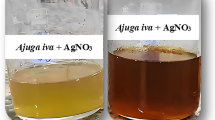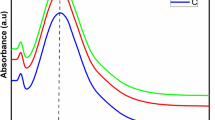Abstract
The use of silver nanoparticles (AgNPs) produced from sustainable resources to improve photovoltaic properties of dye-sensitized solar cells is gaining interest due to the growing demand for clean and green energy sources. In this study, leaf (HY) and flower (HC) extracts of Golden Grass (Helichrysum italicum) were used to produce AgNPs with a low cost and easy method. The enhancement in power conversion efficiency by adding AgNPs phthalocyanine produced from biomaterials was investigated. The formation of AgNPs is indicated by a strong surface plasmon resonance (SPR) at 441 nm for HY-AgNPs and 448 nm for HC-AgNPs. Spherical AgNPs were formed with an estimated diameter of 22.59 ± 0.71 nm for HY-AgNPs and 21.06 ± 0.95 nm for HC-AgNs, both with a face center cubic crystal structure. On the other hand, the zinc phthalocyanine complex designed for dye-sensitized solar cells was synthesized and characterized. At the same time, the aggregation and fluorescence properties of zinc phthalocyanine were investigated. The photovoltaic properties of the phthalocyanine compound used in the study were examined without and with silver nanoparticle additives. With this doping, the power conversion efficiency percentage increased from 2.32 to 3.41 for HY-AgNPs and from 2.32 to 2.92 for HC-AgNPs. Evaluation of the results reveals that the phthalocyanine compound gains more efficient photovoltaic properties with the doping of AgNPs for dye-sensitized solar cells.








Similar content being viewed by others
References
Ağirtaş MS, Güngördü Solğun D, Yildiko Ü, Özkartal A (2020) Design of novel substituted phthalocyanines; synthesis and fluorescence, DFT, photovoltaic properties. Turk J Chem 44:1574–1586. https://doi.org/10.3906/kim-2007-40
Ahmed S, Ahmad M, Swami BL, Ikram S (2016) A review on plants extract mediated synthesis of silver nanoparticles for antimicrobial applications: a green expertise. J Adv Res 7(1):17–28. https://doi.org/10.1016/j.jare.2015.02.007
Alahmadi TA, Pugazhendhi A (2021) Green synthesis of silver nanoparticles from aqueous extract of Ctenolepis garcini L. and assess their possible biological applications. Process Biochem 107:91–99. https://doi.org/10.1016/j.procbio.2021.05.008
AL-Rousan N, Isa NAM, Desa MKM (2018) Advances in solar photovoltaic tracking systems: a review. Renew Sustain Energy Rev 82:2548–2569
Anand K, Kaviyarasu K, Muniyasamy S, Roopan SM, Gengan RM, Chuturgoon AA (2017) Biosynthesis of silver nanoparticles using agroforestry residue and their catalytic degradation for sustainable waste management. J Cluster Sci 28(4):2279–2291
Chandra H, Kumari P, Bontempi E, Yadav S (2020) Medicinal plants: treasure trove for green synthesis of metallic nanoparticles and their biomedical applications. Biocatal Agric Biotechnol 24:101518
Chinou IB, Roussis V, Perdetzoglou D, Loukis A (1996) Chemical and biological studies on two Helichrysum species of Greek origin. Planta Med 62:377–379
Chung I, Lee B, He J, Chang RPH, Kanatzidis MG (2012) All-solid-state dye-sensitized solar cells with high efficiency. Nature 485(7399):486–489. https://doi.org/10.1038/nature11067
Dave PN, Chopda LV (2014) Application of iron oxide nanomaterials for the removal of heavy metals. J Nanotechnol. https://doi.org/10.1155/2014/398569
Elangovan K, Elumalai D, Anupriya S, Shenbhagaraman R, Kaleena PK, Murugesan K (2015) Phyto mediated biogenic synthesis of silver nanoparticles using leaf extract of Andrographis echioides and its bio-efficacy on anticancer and antibacterial activities. J Photochem Photobiol B, Biol 151:118–124. https://doi.org/10.1016/j.jphotobiol.2015.05.015
Fahimirad S, Ajalloueian F, Ghorbanpour M (2019) Synthesis and therapeutic potential of silver nanomaterials derived from plant extracts. Ecotoxicol Environ Saf 168:260–278
Galbany-Casals M, Blanco-Moreno JM, Garcia-Jacas N, Breitwieser I, Smissen RD (2011) Genetic variation in Mediterranean Helichrysum italicum (Asteraceae; Gnaphalieae): Do disjunct populations of subsp. microphyllum have a common origin? Plant Biol 13:678–687
Garcia MA (2011) Surface plasmons in metallic nanoparticles: fundamentals and applications. J Phys D: Appl Phys 44(28):283001. https://doi.org/10.1088/0022-3727/44/28/283001
Ghadari R, Sabri A, Saei P-S, Kong F-T, Marques HM (2020) Phthalocyanine-silver nanoparticle structures for plasmon-enhanced dyesensitized solar cells. Sol Energy 198:283–294
Güngördü Solğun D, Horoz S, Ağırtaş MS (2018) Synthesis of novel tetra (4-tritylphenoxy) substituted metallophthalocyanines and investigation of their aggregation, photovoltaic, solar cell properties. Inorg Nano-Met Chem 48(10):508–514. https://doi.org/10.1080/24701556.2019.1572624
Güngördü Solğun D, Yıldıko Ü, Özkartal A, Ağırtaş MS (2021) Photovoltaic performance properties, DFT studies, and synthesis of (E) 3 (diphenxy) acrylic acid substituted phthalocyanine complexes. Chem Pap 75:6285–6295. https://doi.org/10.1007/s11696-021-01786-6
Güngördü Solğun D, Özkartal A, Ağırtaş MS (2023) Synthesis of phthalocyanine complexes carrying caffeic acid groups: increasing photovoltaic performance by doping silver nanoparticles. Energy Sour Part A Recov Utıl Envıron Effects 45(1):2240–2252. https://doi.org/10.1080/15567036.2023
Hellivan PJ (2009) Immortelle’s sustainable resurgence. Perfum Flavor 34:34–40
Hermanto D, Ismillayli N, Fatwa DH, Zuryati UK, Muliasari H, Wirawan R, Prasetyoko D, Suprapto S (2024) Bio-mediated electrochemically synthesis of silver nanoparticles using green tea (Camellia sinensis) leaves extract and their antibacterial activity. S Afr J Chem Eng 47:136–141. https://doi.org/10.1016/j.sajce.2023.11.004
Iravani S (2011) Green synthesis of metal nanoparticles using plants. Green Chem 13(10):2638–2650. https://doi.org/10.1039/c1gc15386b
Isah KU, Jolayemi BJ, Ahmadu U, Kimpa MI, Alu N (2016) Plasmonic effect of silver nanoparticles intercalated into mesoporous betalain-sensitized-TiO2 film electrodes on photovoltaic performance of dye-sensitized solar cells. Mater Renew Sustain Energy 5:10
Jackson RB, Friedlingstein P, Andrew RM, Canadell JG, Le Quéré C, Peters GP (2019) Persistent fossil fuel growth threatens the Paris Agreement and planetary health. Environ Res Lett 14(12):121001. https://doi.org/10.1088/1748-9326/ab57b3
Kalfagiannis N, Karagiannidis PG, Pitsalidis C, Panagiotopoulos NT, Gravalidis C, Kassavetis S, Patsalas P, Logothetidis S (2012) Plasmonic silver nanoparticles for improved organic solar cells. Sol Energy Mater Sol Cells 104:165–174
Kojima A, Teshima K, Shirai Y, Miyasaka T (2009) Organometal halide perovskites as visible-light sensitizers for photovoltaic cells. J Am Chem Soc 131(17):6050–6051. https://doi.org/10.1021/ja809598r
Liu X, Zhang W, Uchida S, Cai L, Liu B, Ramakrishna S (2010) An efficient organic-dye-sensitized solar cell with in situ polymerized Poly(3,4-ethylenedioxythiophene) as a hole-transporting material. Adv Mater 22(20):150–155. https://doi.org/10.1002/adma.200904168
Liu K, Qu S, Zhang X, Tan F, Wang Z (2013) Improved photovoltaic performance of silicon nanowire/organic hybrid solar cells by incorporating silver nanoparticles. Nanoscale Res Lett 8(88):2–6
Mock JJ, Barbic M, Smith DR, Schultz DA, Schultz S (2002) Shape effects in plasmon resonance of individual colloidal silver nanoparticles. J Chem Phys 116(15):6755–6759. https://doi.org/10.1063/1.1462610
Ödemiş Ö, Özdemir S, Gonca S, Arslantaş A, Ağırtaş MS (2022) The study on biological activities of silver nanoparticles produced via green synthesis method using Salvia officinalis and Thymus vulgaris. Turk J Chem 46:1417–1428. https://doi.org/10.55730/1300-0527.3448
Ojeda JJ, Dittrich M (2012) Fourier transform infrared spectroscopy for molecular analysis of microbial cells. Methods Mol Biol. https://doi.org/10.1007/978-1-61779-827-6_8
Ovais M, Khalil AT, Raza A, Khan MA, Ahmad I, Islam M, Saravanan NU, Ubaid MF, Ali M, Shinwarıl K (2016) Green synthesis of silver nanoparticles via plant extracts: beginning a new era in cancer theranostics. Nanomedicine 11(23):3157–77
Ramteke C, Chakrabarti T, Sarangi BK, Pandey R-A (2013) Synthesis of silver nanoparticles from the aqueous extract of leaves of ocimum sanctum for enhanced antibacterial activity. J Chem. https://doi.org/10.1155/2013/278925
Sauvage F, Di Fonzo F, Li Bassi A, Casari CS, Russo V, Divitini G, Ducati C, Bottani CE, Comte P, Graetzel M (2010) Hierarchical TiO2 photoanode for dye-sensitized solar cells. Nano Lett 10(7):2562–2567. https://doi.org/10.1021/nl101198b
Urbani M, Ragoussi M-E, Nazeeruddin MK, Torres T (2019) Phthalocyanines for dye-sensitized solar cells. Coord Chem Rev 381:1–64
Yella A, Lee H-W, Tsao HN, Yi C, Chandiran AK, Nazeeruddin MdK, Diau EW-G, Yeh C-Y, Zakeeruddin SM, Grätzel M (2011) Porphyrin-sensitized solar cells with cobalt (II/III)–based redox electrolyte exceed 12 percent efficiency. Science 334(6056):629–634. https://doi.org/10.1126/science.1209688
Yüzeroğlu M, Keser Karaoğlan G, Gümrükçü Köse G, Erdoğmuş A (2021) Synthesis of new zinc phthalocyanines including schiff base and halogen; photophysical, photochemical, and fluorescence quenching studies. J Mol Struct 1238:130423
Zabat LH, Sadaoui NA, Abid M, Sekrafi H (2022) Threshold effects of renewable energy consumption by source in U.S. economy. Electr Power Syst Res 213:108669
Zeinidenov AK, Aimukhanov AK, Kambar DS, Ilyassov BR, Zavgorodniy, (2021) Effects of phthalocyanine nanostructure on photovoltaic performance of its polymer composite thin films. Mater Chem Phys 267:124680
Zheng J, Du J, Wang B, Klemes JJ, Liao Q, Liang Y (2023) A hybrid framework for forecasting power generation of multiple renewable energy sources. Renew Sust Energ Rev 172:113046
Zhou H, Wu L, Gao Y, Ma T (2011) Dye-sensitized solar cells using 20 natural dyes as sensitizers. J Photochem Photobiol A 219(2–3):188–194. https://doi.org/10.1016/j.jphotochem.2011.02.008
Acknowledgements
The authors thank the Scientific Research Projects Unit of Van Yuzuncu Yıl University for their contributions (FDK-2022-10325).
Author information
Authors and Affiliations
Corresponding author
Ethics declarations
Conflict of interest
The authors declare no conflict of interest.
Additional information
Publisher's Note
Springer Nature remains neutral with regard to jurisdictional claims in published maps and institutional affiliations.
Supplementary Information
Below is the link to the electronic supplementary material.
Rights and permissions
Springer Nature or its licensor (e.g. a society or other partner) holds exclusive rights to this article under a publishing agreement with the author(s) or other rightsholder(s); author self-archiving of the accepted manuscript version of this article is solely governed by the terms of such publishing agreement and applicable law.
About this article
Cite this article
Ödemiş, Ö., Ağırtaş, M.S., Güngördü Solğun, D. et al. Effect of silver nanoparticles prepared by green chemistry on the photovoltaic properties of zinc phthalocyanine. Chem. Pap. 78, 3735–3746 (2024). https://doi.org/10.1007/s11696-024-03343-3
Received:
Accepted:
Published:
Issue Date:
DOI: https://doi.org/10.1007/s11696-024-03343-3




